Khmer architects had a keen sense of drama, but you have to linger at the temples for a while to fully appreciate it.
Ta Prohm and Preah Khan are two of the best monuments where you can immerse yourself in Angkor’s heyday. We’ll explore some of the ideas that went into them.
Both temples have a big contrast between large open spaces and dense construction. And at Ta Prohm and Preah Khan, large means LARGE. A laterite wall that’s 3,280 x 1968 feet encloses Ta Prohm. Preah Khan’s outermost wall measures 2296 x 2624 feet. Most of the enclosed area today is open forest.
Back in the day, monks, priests and administrators lived in it, but homes were wooden and thatched, and they’re long-gone. But these areas must have bustled when the temples were newly built in the late 12th century.
I could hear the chiming of traditional Khmer orchestras long before the musicians were within view. The large open area allows notes to travel, and the xylophones, gongs and flutes of Khmer bands carry very well. They pierce the sultry air like waves of energy from the source of creation.
Anticipation builds as you walk through the open area towards the central section of temples. Angkor Wat and the royal palace also have striking contrasts between large open spaces and dense central constructions. All must have been designed with processions in mind. Both the expansive space and the congested architecture in the middle appear larger than life, and both reinforce your feelings of awe.
I could imagine chanting priests, thousands of monks, and elephants carrying the king and nobles in processions towards the central buildings at Ta Prohm and Preah Khan. People’s heartbeats must have quickened as they approached the middle section.
Above is a photo of one of the gatehouses of Preah Khan’s central section. Imagine that you’re in a procession–
–and the entrance to the dense cluster of central shrines slowly gets closer. You’re under the tropical sun, and thus in a different world than the one that northern Europeans lived in, who were building Gothic cathedrals at the same time. You can feel the energy that created these enormous enclosures and opulent forms pulsating around you.
The Gothic cathedrals’ art is centered on a single theme: Jesus’ pivotal place in history and in humanity’s salvation. Their stained glass windows detailed Biblical stories that supported their theology. But the king who built Ta Prohm and Preah Khan, Jayavarman VII, mixed several theologies, and they blended with the beaming sun. The central sections’ temples were brightly painted and gilded when they were new. The abundance of theologies, art foms and energy must have made people feel that they were approaching the source of creation. We’ll go right to its center in the next post.

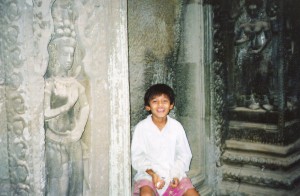
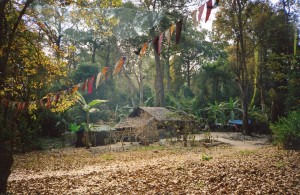
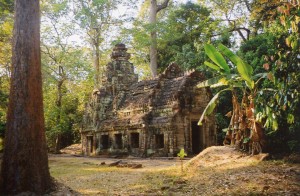
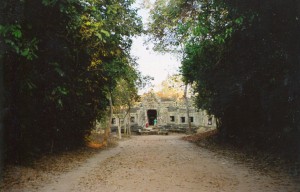
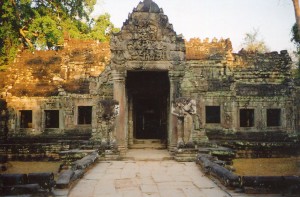
Comments on this entry are closed.